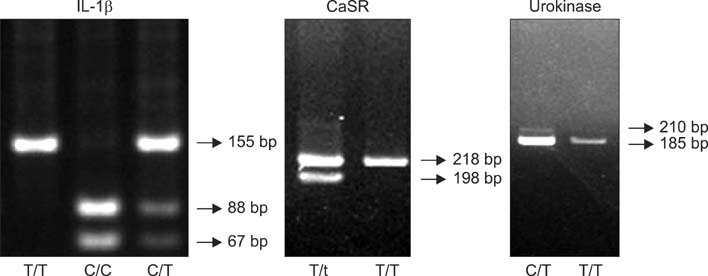Korean J Urol.
2011 May;52(5):340-344.
Interleukin-1beta, Calcium-Sensing Receptor, and Urokinase Gene Polymorphisms in Korean Patients with Urolithiasis
- Affiliations
-
- 1Department of Urology, College of Medicine, Chung-Ang University, Seoul, Korea. kthlmk@hanafos.com
- 2Department of Laboratory Medicine, College of Medicine, Chung-Ang University, Seoul, Korea.
Abstract
- PURPOSE
There are various causes of ureter calculi, and genetic factors are known to play a role. Interleukin-1beta (IL-1beta) and calcium-sensing receptor (CaSR) genes are related to hypercalciuria, and urokinase is related to the formation of calcium oxalate stones. This study investigated polymorphisms in IL-1beta, CaSR, and urokinase in patients with urolithiasis and healthy controls.
MATERIALS AND METHODS
Urolithiasis patients treated at Chung-Ang University Hospital were enrolled from January 2007 to December 2008. The control group of volunteers displayed normal urinalysis findings in the health screening, no stones identified by ultrasonography, and no history of urolithiasis. DNA extracted from peripheral blood was analyzed by the polymerase chain reaction. Patients were genetically screened for mutations in IL-1beta (484 urolithiasis patients, 208 controls), CaSR (433 urolithiasis patients, 197 controls), and urokinase (370 urolithiasis patients, 167 controls). Stone metabolic study was done to see the differences between the metabolic factors and to discern normal genes from polymorphic genes.
RESULTS
According to the genotype frequency and allele frequency analysis, there were no statistically significant differences between IL-1beta, CaSR, and urokinase genes. Also, the analysis between genotypes and metabolic factors did not show statistically significant differences between the three genes.
CONCLUSIONS
In Korean urolithiasis patients, IL-1beta, CaSR, and urokinase gene polymorphisms do not differ from those of healthy individuals. A larger-scale study is needed to confirm the need for other genetic markers of urolithiasis.
MeSH Terms
-
Calcium Oxalate
Calculi
DNA
Gene Frequency
Genetic Markers
Genotype
Humans
Hypercalciuria
Interleukin-1beta
Mass Screening
Polymerase Chain Reaction
Polymorphism, Genetic
Receptors, Calcium-Sensing
Ureter
Urinalysis
Urokinase-Type Plasminogen Activator
Urolithiasis
Calcium Oxalate
DNA
Genetic Markers
Interleukin-1beta
Receptors, Calcium-Sensing
Urokinase-Type Plasminogen Activator
Figure
Reference
-
1. Danpure CJ. Genetic disorders and urolithiasis. Urol Clin North Am. 2000. 27:287–299.2. McGeown MG. Inheritance of calcium renal stones. Lancet. 1968. 1:866.3. Resnick M, Pridgen DB, Goodman HO. Genetic predisposition to formation of calcium oxalate renal calculi. N Engl J Med. 1968. 278:1313–1318.4. Goodman HO, Holmes RP, Assimos DG. Genetic factors in calcium oxalate stone disease. J Urol. 1995. 153:301–307.5. Chen WC, Wu HC, Lin WC, Wu MC, Hsu CD, Tsai FJ. The association of androgen- and oestrogen-receptor gene polymorphisms with urolithiasis in men. BJU Int. 2001. 88:432–436.6. Chen WC, Wu HC, Chen HY, Wu MC, Hsu CD, Tsai FJ. Interleukin-1beta gene and receptor antagonist gene polymorphisms in patients with calcium oxalate stones. Urol Res. 2001. 29:321–324.7. Chen WC, Chen HY, Wu JY, Chen YT, Tsai FJ. Osteocalcin gene Hind III polymorphism is not correlated with calcium oxalate stone disease. Urol Res. 2001. 29:98–101.8. Jackman SV, Kibel AS, Ovuworie CA, Moore RG, Kavoussi LR, Jarrett TW. Familial calcium stone disease: TaqI polymorphism and the vitamin D receptor. J Endourol. 1999. 13:313–316.9. Hofbauer LC, Lacey DL, Dunstan CR, Spelsberg TC, Riggs BL, Khosla S. Interleukin-1beta and tumor necrosis factor-alpha, but not interleukin-6, stimulate osteoprotegerin ligand gene expression in human osteoblastic cells. Bone. 1999. 25:255–259.10. Hebert SC. Extracellular calcium-sensing receptor: implications for calcium and magnesium handling in the kidney. Kidney Int. 1996. 50:2129–2139.11. Mittal RD, Bid HK, Manchanda PK, Kapoor R. Association of interleukin-1beta gene and receptor antagonist polymorphisms with calcium oxalate urolithiasis. J Endourol. 2007. 21:1565–1570.12. Coe FL, Parks JH, Moore ES. Familial idiopathic hypercalciuria. N Engl J Med. 1979. 300:337–340.13. Breslau NA, Coe FL. Coe FL, Favus MJ, Pak CY, Parks JH, Preminger GM, editors. Management of idiopathic hypercalciuria. Kidney stones: medical and surgical management. 1996. Philadelphia: Lippincott Williams & Wilkins;773–785.14. Ferreira LG, Pereira AC, Heilberg IP. Vitamin D receptor and calcium-sensing receptor gene polymorphisms in hypercalciuric stone-forming patients. Nephron Clin Pract. 2010. 114:c135–c144.15. Vezzoli G, Tanini A, Ferrucci L, Soldati L, Bianchin C, Franceschelli F, et al. Influence of calcium-sensing receptor gene on urinary calcium excretion in stone-forming patients. J Am Soc Nephrol. 2002. 13:2517–2523.16. Tsai FJ, Lin CC, Lu HF, Chen HY, Chen WC. Urokinase gene 3'-UTR T/C polymorphism is associated with urolithiasis. Urology. 2002. 59:458–461.17. Mittal RD, Bid HK, Kumar A, Bhandari M. Association of urokinase 3'-UTR polymorphism with calcium oxalate nephrolithiasis. J Endourol. 2006. 20:157–160.
- Full Text Links
- Actions
-
Cited
- CITED
-
- Close
- Share
- Similar articles
-
- Erratum: Interleukin-1beta, Calcium-Sensing Receptor, and Urokinase Gene Polymorphisms in Korean Patients with Urolithiasis
- Relationship between spontaneous preterm birth and polymorphisms of Interleukin-1beta and Interleukin-1 receptor antagonist in Korean women
- Calcium Sensing Receptor
- Polymorphisms of interleukin-1beta promoter in simple febrile seizures
- IL-1beta and IL-1 Receptor Antagonist Gene Polymorphisms in Myasthenia Gravis


